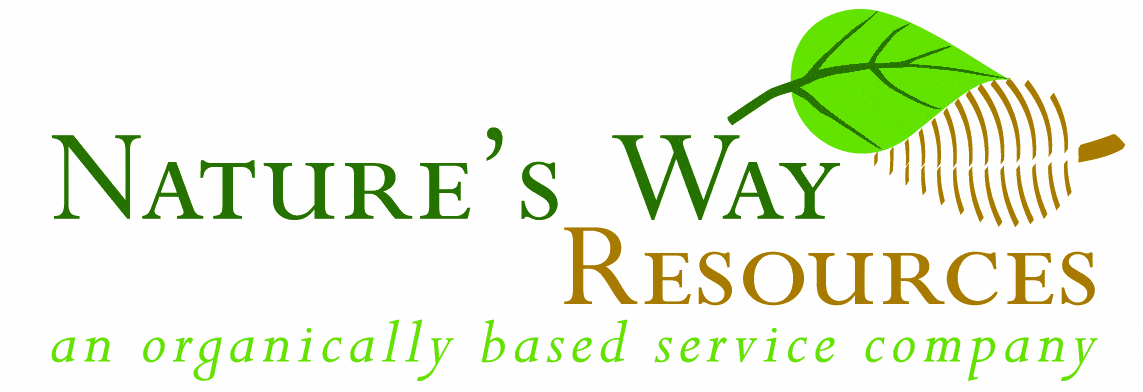
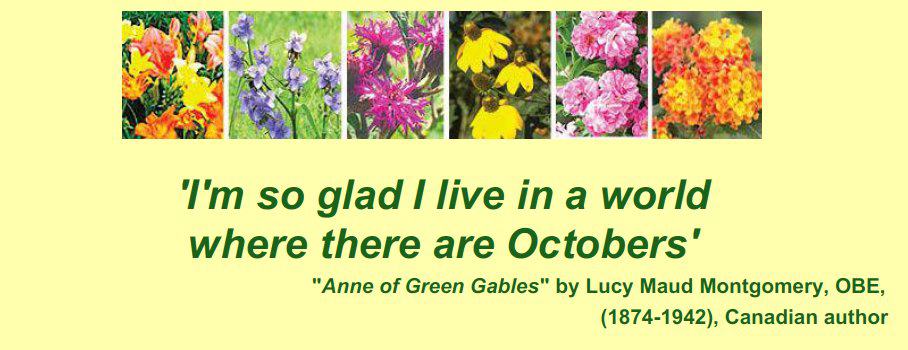
ME TOO, ANNE . . .tho our reasons certainly differ. Summers aren’t nearly as hot on Prince Edward Island and winters much colder than here. But, like Anne, we need to treasure October. Especially now that Farmers’ Almanac‘s newly-posted Texas winter forecast is titled: “The Brrr Is Back.” On the other hand, The OLD Farmer’s Almanac (yes, are two) predicts a milder winter for those of us in the mid-to-southern part of the state. I vote for the OLD folks!
Fortunately our calendar (below) includes a wealth of upcoming plant sales with trees, shrubs, perennials & annuals they know from experiences do extremely well in our area. Two great examples:

SAN JACINTO COUNTY MASTER GARDENERS’ Sat.,
Oct.7, sale’s includes native and passalong plants such as, l to r, above: Button Bush (Cephalanthus occidentalis) — a great choice for low spots — and American Beauty Berry (Callicarpa americana), beautiful, super-hardy in semi- shaded areas — two often difficult sites. Other super- hardies include Peggy Martin roses (right) and Texas
lantana! SJCMG Sale: 9am-1pm at Shepherd Community Center, 10251 Tex 150, Shepherd.
IN MEANTIME, MARGARET PIERCE, The Garden Club of
Houston, gives us a peek at just a few of her personal collection — all mentioned will be available Thurs-Sat, Oct. 12-14 at the81st annual Garden Club of Houston Bulb and Plant Mart, Houston tradition since 1941!
Featured in the Natives in the City Booth will be many natives grown from seed by GCH members. Seeds of choice natives were also provided by Native Plant Society of Texas/Houston Chapter, Memorial Park Conservancy, and native plant expert Lauren Simpson’s St Julian’s Crossing – wildlife habitat.
* * *
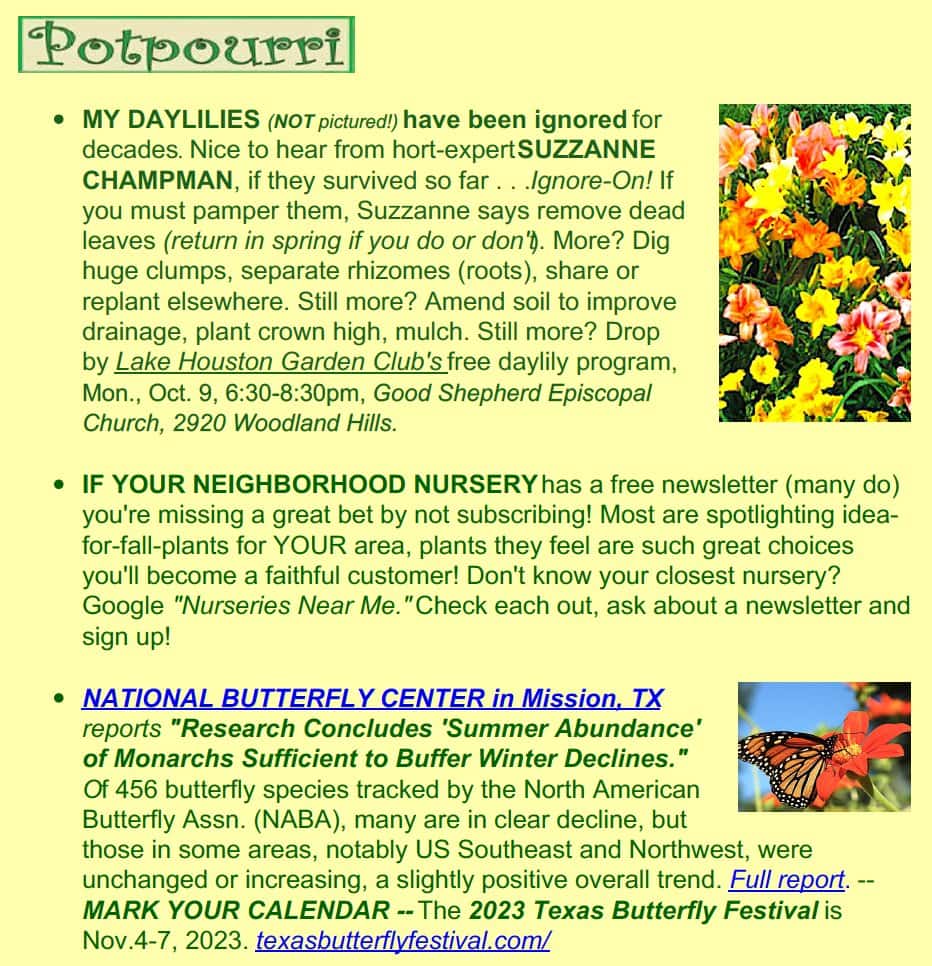
NOW . . . moving our native plantings to higher level!
* * *
Brenda Beust Smith’s column is based on her 40+ years
as Houston Chronicle’s Lazy Gardener Email: lazygardenerbrenda@gmail.com
— Note: This column’s gardening advice focuses ONLY on
the Greater Houston area. Personal reports MUST include your area.
* BRENDA’S “LAZY GARDENER GUIDE” is no longer sold. H owever, free pdf copies aupon request at lazygardenerbrenda@gmail.com
* * *
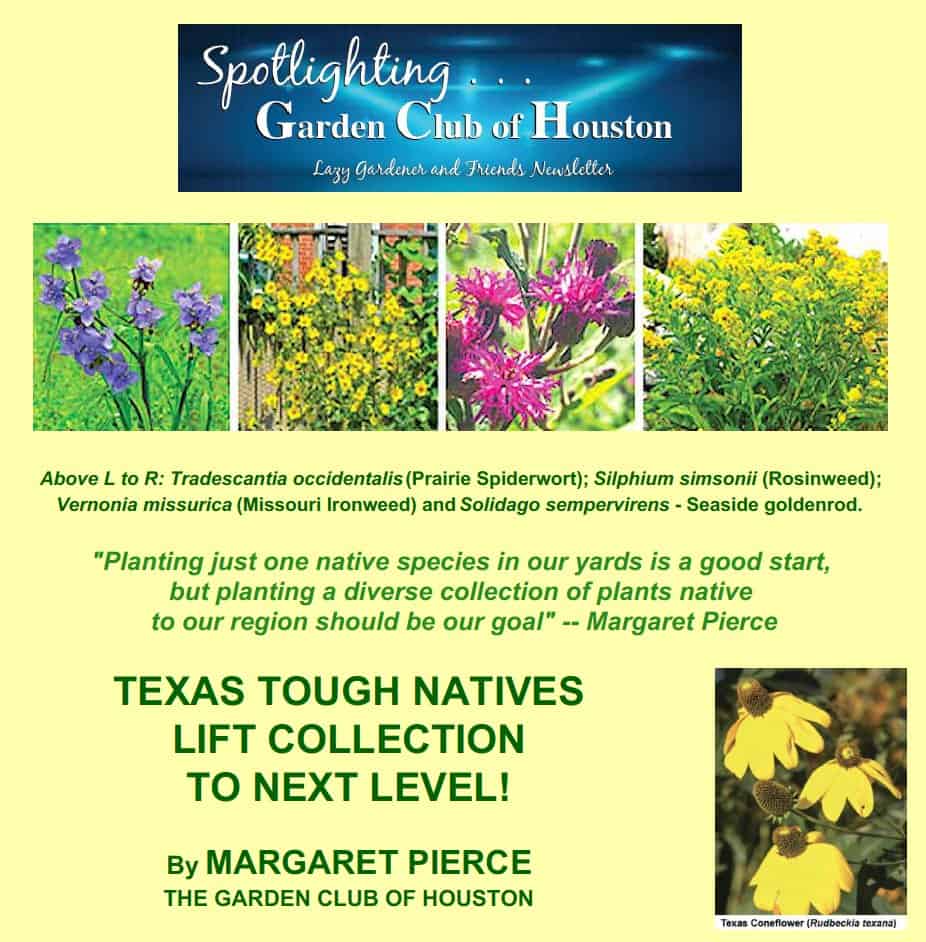
Native plants do not operate in a vacuum – they, along with the native bugs, bees, butterflies, and birds thrive when they exist symbiotically in their shared ecosystem. Accordingly, planting just one native species in our yards is a good start, but planting a diverse collection of plants native to our region should be our goal.
Our yards should contain flowers that:
have different bloom color, shape and time of bloom, offer habitat, such as grasses, and
produce berries and seeds.
Other helpful components include a source of water, ground areas with leaf litter, and native trees and shrubs for cover/habitat.
It is estimated that to realize benefits offered by planting natives in your yard, at least 50 – 70% of the plants should be native. A few cultivars of natives (“nativars”) are OK, but the ecosystem services they offer are often less than what their true native ancestor provides.
To support your native plants, apply native mulch several times a year, adding a couple of inches to all your beds at each application. This provides weed control, water conservation, protection from heat and frost, and nutrients that are appropriate for our natives as the mulch breaks down. Nature’s Way Resources has a wonderful selection of native mulches and composts, by the way.
And remember, native gardens require care just as any landscape. You will still need to water, weed, and trim. However, you will benefit from having to water less, and you will attract many more pollinators, and support the other critters in your yard’s ecosystem. Little or no fertilizer is required if your soil is healthy and you are applying mulch regularly.
In my yard, here are just a few of the natives and a few nativars that have survived the drought and heat unscathed this summer. These are tough plants!
Asclepias perinis – Aquatic Milkweed Calicarpa americana – American Beautyberry Conoclinium coelestinum – Blue Mistflower Echinacea purpurea – Purple Coneflower Muhlenbergia capillaris – Gulf muhly
Rivina humilis – Pigeonberry Rudbeckia texana – Texas Coneflower Salvia coccínea – Scarlet Sage
Salvia farinaceae – Mealy Cup Sage
Silphium simsonii – Rosinweed
Solidago sempervirens – Seaside Goldenrod Tradescantia occidentalis – Prairie Spiderwort Verbesina virginica – Frostweed
Vernonia missurica – Missouri Ironweed
Sourcing native plants can be a challenge. True native plants can also be found at Houston Audubon’s Natives Nursery, Nature’s Way Resources, and at native plant sales put on by Houston Arboretum, Cockrell Butterfly Museum/Houston Museum of Natural Science, among other resources.
* * *
EDITOR’S NOTE:
Fri., Oct. 13: 9am-3pm, & Sat., Oct. 14, 9am-2pm The Church of St. John the Divine, 2450 River Oaks Blvd. (Link above includes inventory with pictures)
NOTE: Local nurseries are carrying more natives, along with“nativars“…a cultivar derived from native parents and bred for a particular trait, typically resulting in a loss of genetic diversity. Nativars can have sterile flowers and produce no seeds.” This is such new territory for everyone. Your best bet: join a Texas Native Plant Society near you: npsot.org/chapters/ . . . so you shop with more confidence!
* * *

NEWS FROM THE WONDERFUL WORLD OF SOIL AND PLANTS # 258
Subject: fluoride Frogfruit ginger edible fungi and books diet and dementia
We have discussed on numerous occasions the harm fluoride in our public water systems does to soils and plants. A new study has found that hydroxyapatite works as good or better than fluoride in preventing
cavities. Hydroxyapatite is a calcium phosphate mineral found in our bones and is beneficial to our health. Frontiers in Public Health (2023).
There is no need to continue poisoning our soil and hurting our plants using water with fluoride in it. I was in Austin last week and saw on their local news another town in the area has voted to remove fluoride from the water system.
This past summer has been brutal on our plants, especially our lawns. However, I have noticed that one of our native plants has been thriving. It is known as Frogfruit (Phyla nodiflora) which is a groundcover species in the verbena family.
This perennial plant can tolerate drought, floods, scorching heat, hard freezes, and other abuse and grows in part shade to full sun. It has small white flowers often with leaves turning orange, yellow, or even purple. It typically grows only 4-6 inches tall so very little maintenance is required.
It blooms from mid-spring into fall hence the flowers provide pollen almost all season for our pollinators and other insects.
It is also the host plant for the phaon cresecent, white peacock, and buckeye butterflies.
Additionally, this plant will grow in compacted degraded soils and help them recover by supporting the beneficial microbes the soil needs.
Ginger root has been used medicinally for thousands of years as it stimulates our immune system and promotes health.
Researchers at the Technical University of Munich have discovered one of the reasons why ginger works. They discovered that a component found in pungent ginger, stimulates white blood cells, putting them into a more active mode ready to protect the body against invading bacteria. Molecular Nutrition & Food Research (2022)
We often talk about the importance of fungi to plants and soils. Over the last few years there has been a lot of research on the culinary and health benefits of eating fungi.
Many species of fungi produce fruiting spores that we call mushrooms which not only taste good (I love a good steak covered in mushrooms or deep fried with salt) but are highly nutritious.
A study from the University of Queensland have discovered an active compound in “Lion’s Mane” mushrooms that has a significant effect on stimulating the growth of human brain cells and improving one’s memory. Journal of Neurochemistry (2023)
For those whom want to learn more about fungi and how they effect our lives a couple good books are:
“Mycorrhizal Planet – How Symbiotic Fungi Work with Roots to Support Plant Health and Build Soil Fertility”, Michael Phillips, 2017, Chelsea Publishing,
ISBN: 978-1603586580
Michael has written this book in a down-to-earth format that is practical, warm, and often humorous. All gardeners need to understand the information in this book. It is extremely up to date on the fungi-plant relationship and how critical it is, IF we want to grow beautiful flowers, delicious fruits, magnificent shrubs, or trees.
Mycelium Running, How Mushrooms Can Help Save the World, by Paul Staments, Ten Speed Press, ISBN 978-1-58008-579-3
This book is a deeper look at fungus and how it affects the world around us from plants to humans. It is divided into three parts; the first is how we experience fungal mycelium in nature, the second part is how we use fungi and the third is on the culinary and nutrition aspects of fungi.
The Orthomolecular New Service (February 2023) had an article summarizing many research papers. They found that most dementia is driven by diet NOT genes.
It was the environment (air, water, food, etc.) that we are exposed to that determines if dementia occurs. “Those with a healthy diet were about seven times less likely to have age-related cognitive decline or dementia that those with an ‘average diet’ and nine times less likely to develop dementia than those with an unfavorable diet.”
The reasons to eat foods grown and produced using organic methods continues to grow.
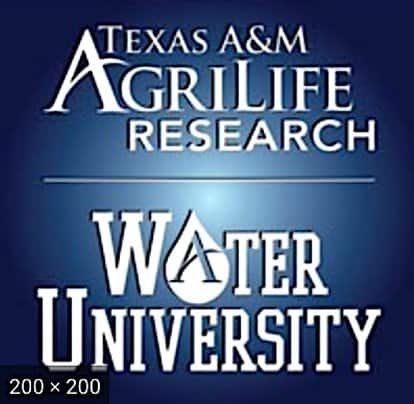
SPONSORSHIP
If you are interested in becoming a sponsor, please contact us at 936-273-1200 or send an e-mail to: lazygardenerandfriends@gmail.com
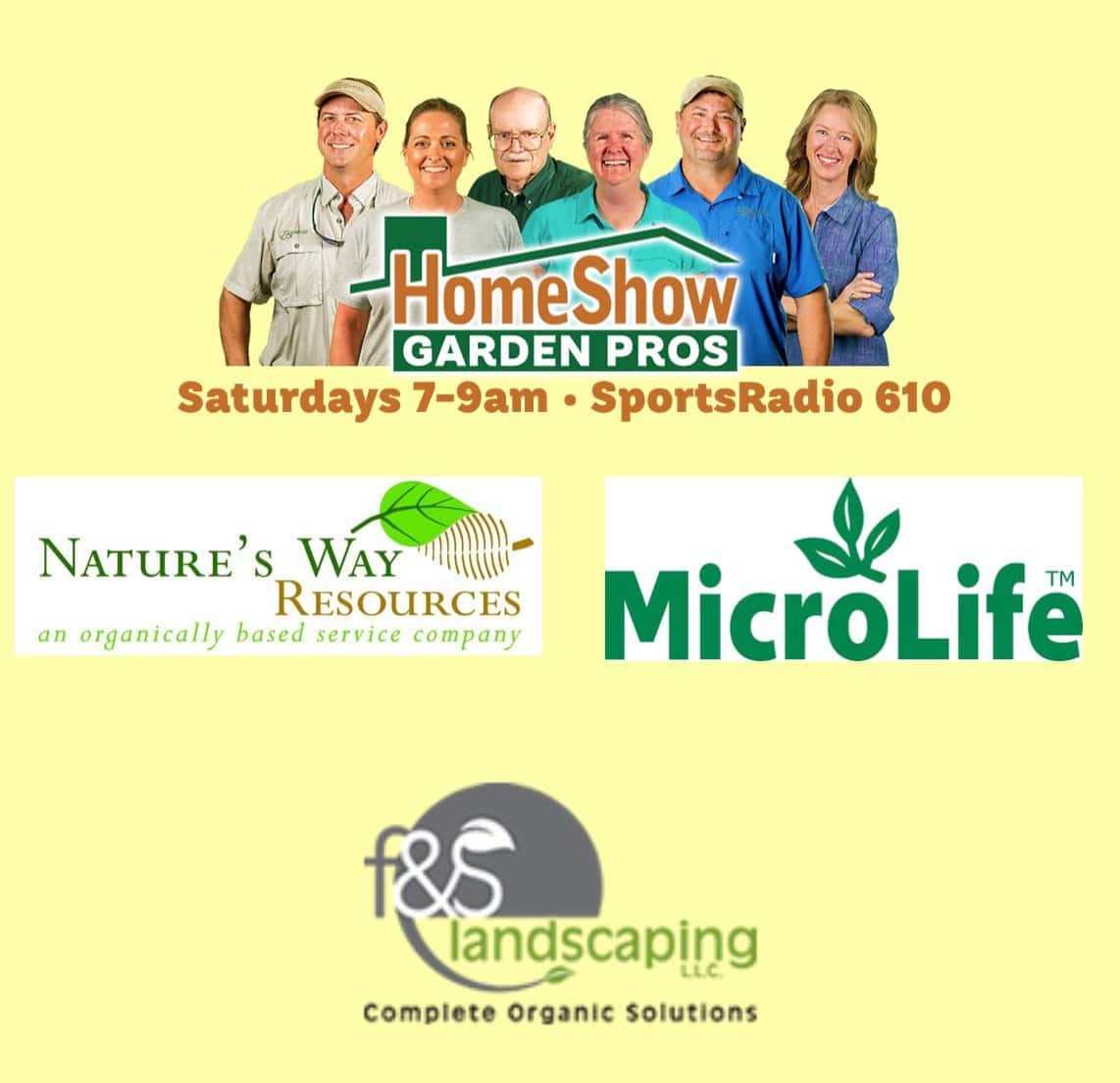
ABOUT US
BRENDA BEUST SMITH WE KNOW HER BEST AS THE LAZY GARDENER . . . but Brenda Beust Smith is also:
- a national award-winning writer & editor
- a nationally-published writer & photographer
- a national horticultural speaker
- a former Houston Chronicle reporter
When the Chronicle discontinued Brenda’s 45-year-old Lazy Gardener” print column — started in the early ’70s as a fun side-project to reporting, it then ranked as the longestrunning, continuously-published local newspaper column in the Greater Houston area. The name, she says, is not just fun, it’s true. Brenda’s gradual sideways step from reporter into gardening writing led first to an 18-year series of when-to-do-what Lazy Gardener Calendars, then to her Lazy Gardener’s Guide book which morphed into her Lazy Gardener’s Guide on CD, which she now emails free upon request. Brenda became a Harris County Master Gardener and, over the years, served on theboards of many Greater Houston area horticulture organizations. She hosted local radio and TV shows, most notably a 10+-year Lazy Gardener specialty shows on HoustonPBS (Ch. 8) and her call-in “EcoGardening” show on KPFT-FM. For over three decades, Brenda served as Assistant Production Manager of the GARDEN CLUB OF AMERICA’S “BULLETIN” magazine. Although still an active broad-based freelance writer, Brenda’s main focus now is THE LAZY GARDENER & FRIENDS HOUSTON GARDEN NEWSLETTER with John Ferguson and Pablo Hernandez of Nature’s Way Resources. A native of New Orleans and graduate of St. Agnes Academy and the University of Houston, Brenda lives in Humble, TX, and is married to the retired Aldine High School Coach Bill Smith. They have one son, Blake. Regarding this newsletter, Brenda is the lead writer, originator of it and the daily inspiration for it. We so appreciate the way she has made gardening such a fun way to celebrate life together for such a long time.
JOHN FERGUSON John is a native Houstonian and has over 27 years of business experience. He owns Nature’s Way Resources, a composting company that specializes in high quality compost, mulch, and soil mixes. He holds a MS degree in Physics and Geology and is a licensed Soil Scientist in Texas. John has won many awards in horticulture and environmental issues. He represents the composting industry on the Houston-Galveston Area Council for solid waste. His personal garden has been featured in several horticultural books and “Better Homes and Gardens” magazine. His business has been recognized in the Wall Street Journal for the quality and value of their products. He is a member of the Physics Honor Society and many other professional societies. John is is the co-author of the book Organic Management for the Professional. For this newsletter, John contributes articles regularly and is responsible for publishing it.
PABLO HERNANDEZ Pablo Hernandez is the special projects coordinator for Nature’s Way Resources. His realm of responsibilities include: serving as a webmaster, IT support, technical problem solving/troubleshooting, metrics management and quality control. Pablo helps this newsletter happen from a technical support standpoint.
Download the Newsletter with Our Events Calendar Below!
